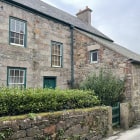
The Société Jersiaise excavated the mound at La Hougue Bie during September 1924 and discovered the passage grave beneath.


Equinox
The chamber of the passage grave was probably a sacred place, both rituals and ceremonies may have taken place here. The structure aligns with the rising sun at the spring and autumn equinoxes – sunlight reaches the end of the passage grave if the weather is clear. This gives the stone at the far end a beautiful glow which may have had special meaning for the Neolithic people using the site.

Finds from La Hougue Bie
Objects found during excavations at La Hougue Bie give us insights into the lives of the Neolithic people who built and used the site.
Pottery
The remains of 19 pottery vessels, known as vase-supports, were excavated from the centre of the chamber. Some of these had decorative lines on them. It appears that the vessels were deliberately broken, perhaps as part of a ritual. The saucers show signs of burning, so they were used as lamps or for the ritual burning of offerings.

Human bone
A small amount of human bone from at least eight people was found scattered on the floor close to the side chambers. Of the eight people found, two were definitely female and four were definitely male. The evidence suggests that their bodies were exposed to the elements to decay or had previously been buried elsewhere.

Shell
Limpet shells were found on top of some of the capstones, placed there during the construction of the mound. The practice of putting limpet shells with human bodies seems to have been a uniquely Channel Islands custom.

Animal bone
Cattle, sheep, pig and bird bones were found scattered on the floor of the chamber. They may have been food offerings. The burial of cattle suggests people had a close relationship with their herds.

Personal ornament
Two beads were found. In some societies personal possessions are buried with the owner.
Tools
A number of flint tools were discovered including four transverse arrowheads.

Quern
A large broken quern was found buried beneath the slab at the entrance to the end cell. It might have had symbolic significance, possibly buried with seed and associated with ideas of renewal.

Cist
A small rectangular sunken box or ‘cist’, originally covered by three stone slabs, contained fragments of pottery and pebbles.
‘Cup marks’
Two stones of the side chamber are decorated with carved ‘cup marks’. Archaeologists don’t know why they were there or if they had any symbolic meaning.












